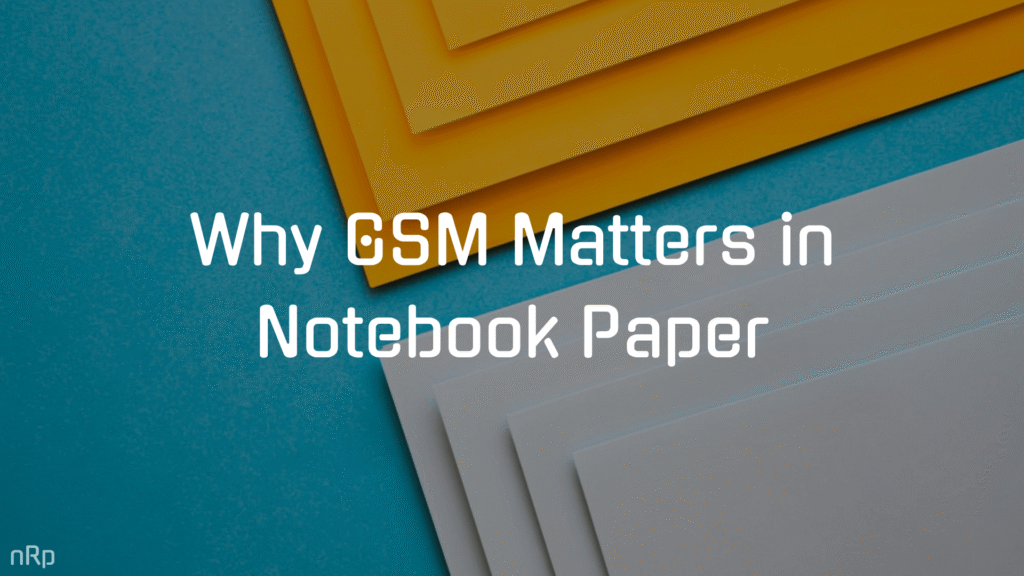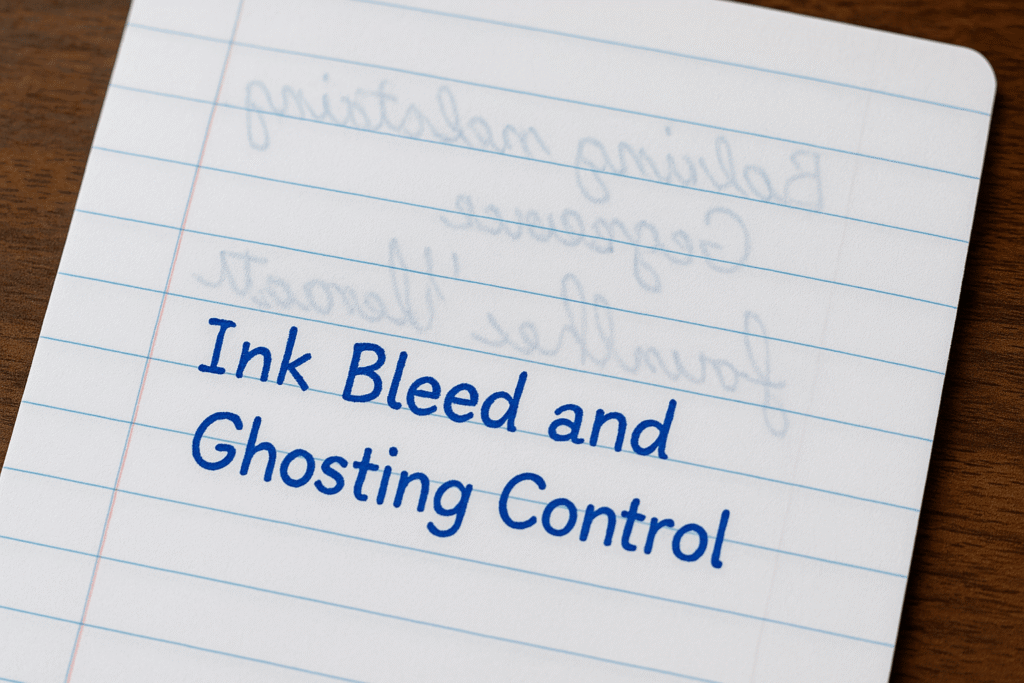
The Answer to the question of why GSM matters in notebook paper lies in the fact of Role of GSM in Notebook Paper. When selecting a notebook, one often considers design, size, and brand factors. However, a crucial yet frequently overlooked aspect is the paper’s GSM, or grams per square meter. This metric significantly influences the notebook’s quality, affecting writing experience, durability, and suitability for various writing instruments.
Understanding GSM: The Basics
GSM (grams per square meter) is a standard measurement that tells you the weight of paper. One square meter of paper that weighs 80 grams has a GSM of 80. The higher the GSM number, the thicker and heavier the paper.
Think of it this way:
Low GSM (e.g., 60-80 GSM) = Thin paper, lightweight, may show ink on the back.
High GSM (e.g., 100-160+ GSM) = Thick paper, opaque, great for heavy writing or drawing.
Fun Fact: GSM doesn’t directly tell you the thickness, but generally, the heavier the paper, the thicker it is!
Also Check: How Notebooks are Made
Why GSM Matters in Notebook Paper?
1. Writing Experience
One of the most noticeable impacts of GSM is how your pen interacts with the paper. If the paper is too thin:
Ink might bleed through to the next page.
Ballpoint or gel pens may scratch or tear it.
Pencils might feel rough or smudgy.
On the other hand, a high GSM paper (90 GSM or more) feels smoother, offers better pressure resistance, and supports even heavy inks from fountain pens or markers.
Best for: Students, journaling enthusiasts, professionals who use gel pens or ink pens.
 2. Ink Bleed and Ghosting Control
2. Ink Bleed and Ghosting Control
Have you ever flipped a notebook page only to see the writing on the other side showing through? That’s called ghosting. If the ink seeps through, that’s bleed-through.
Low-GSM papers (below 70) are more prone to both. A higher GSM sheet offers better opacity, meaning:
No distractions from the other side of the page.
Clean, professional-looking notes.
Double-sided writing becomes practical.
Tip: For fountain pen or sketchbook users, aim for 100 GSM and above.
3. Durability and Tear Resistance
Low GSM paper can easily:
Crumple
Tear when turning pages
Deteriorate over time, especially with rough usage
High GSM paper is:
Sturdy, perfect for long-term archiving
Ideal for school bags, office files, or project folders where pages get frequent handling
4. Printability and Finishing
For notebooks that include printed formats (grids, planners, charts), GSM also affects print clarity. Lower GSM paper may warp under ink or toner, while higher GSM paper maintains a crisp, professional appearance.
Also, notebooks with UV coating, lamination, or other finishes often use higher GSM paper to support these techniques.
You might find this post interesting: Why Quality Papers Matters
Common GSM Ranges in Notebooks
| GSM Range | Usage | Features |
|---|---|---|
| 60-70 GSM | Basic writing | Economical, but prone to bleeding and see-through |
| 70-80 GSM | School notebooks | Standard for students, suitable for ballpoint pens |
| 90-100 GSM | Premium writing | Good opacity, supports gel & ink pens |
| 120-160 GSM | Sketchbooks, journals | Suitable for light painting, marker work |
| Above 160 GSM | Art notebooks | Handles watercolors, brush pens, and heavy ink |
GSM Isn’t Everything — Paper Type Matters Too
It’s important to note that GSM alone doesn’t define notebook quality. Two papers with the same GSM can feel completely different depending on:
Material: Pulp-based vs. cotton-based
Finish: Coated, matte, glossy, textured
Sizing: Surface treatment that controls ink absorption
For example, some paper (52 GSM) is famous in the fountain pen community for its superior ink-handling despite being lightweight. So, consider GSM as the foundation, but always check other specs when available.
How to Choose the Right GSM for Your Needs
Here’s how to match GSM to your usage:
Students:
Ideal GSM: 70–80 GSM
Why: Light, affordable, good for ballpoint or pencil work.
Professionals:
Ideal GSM: 90–100 GSM
Why: Premium feel, zero bleed-through for gel or ink pens in meetings or presentations.
Artists & Creatives:
Ideal GSM: 120–160+ GSM
Why: Can hold up against markers, brush pens, or even light watercolor without warping.
Fountain Pen Lovers:
Ideal GSM: 80–100 GSM or special coated paper
Why: Prevents feathering, ghosting, and gives a smooth glide.
Conclusion: GSM is Your Paper’s DNA
GSM is more than just a number — it defines how your notebook feels, how it performs, and how durable it is over time. Whether you’re buying notebooks in bulk for a school or choosing a personal journal, understanding the role of GSM in notebook paper quality helps you:
- Avoid common paper issues (bleeding, ghosting, tearing)
- Pick the right notebook for the right purpose
- Elevate your writing or drawing experience
Frequently Asked Questions
1. What does GSM mean in notebook paper?
GSM stands for grams per square meter, a standard measurement of paper weight. It indicates how much a square meter of paper weighs and directly influences the thickness, texture, and durability of the paper used in notebooks.
Is higher GSM paper better for notebooks?
Yes, higher GSM paper is usually better in terms of durability, ink resistance, and writing comfort. It’s ideal for fountain pens, gel pens, and artistic work as it prevents ink bleeding and ghosting.
What GSM is Best for School Notebooks?
The best GSM for school notebooks ranges between 70–80 GSM. It’s cost-effective and suitable for daily use with ballpoint pens and pencils, making it perfect for students.
Does GSM affect ink bleeding?
Absolutely. Lower GSM paper tends to absorb more ink, leading to bleed-through and ghosting. A higher GSM (above 90 GSM) reduces this issue by providing a thicker, more absorbent-resistant surface.
What GSM paper is best for fountain pens?
For fountain pens, choose notebooks with 80–100 GSM paper that’s coated or high quality. Brands like Tomoe River use lower GSM but specialized coatings to handle fountain pen ink without bleeding.
Which GSM paper is better for sketching?
70-90 gsm
Next time you pick up a notebook, flip to the specs. If it lists the GSM, you now know exactly what it means and why it matters.

 2. Ink Bleed and Ghosting Control
2. Ink Bleed and Ghosting Control